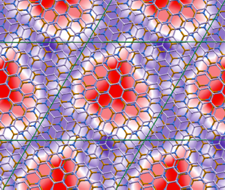We report peculiar transport fingerprints at the secondary Dirac points created by the interaction between graphene and boron nitride layers. By performing ab initio calculations, the electronic characteristics of the moire patterns produced by the interaction between layers are first shown to be in good agreement with experimental data, and further used to calibrate the tight-binding model implemented for the transport study. By means of a real-space order-N quantum transport (Kubo) methodology, low-energy (Dirac point) transport properties are contrasted with those of high-energy (secondary) Dirac points, including both Anderson disorder and Gaussian impurities to respectivelymimic short-range and long-range scattering potentials. Mean free paths at the secondary Dirac points are found to range from 10 nm to a few hundreds of nm depending on the static disorder, while the observation of satellite resistivity peaks depends on the strength of quantum interferences and localization effects.

We report peculiar transport fingerprints at the secondary Dirac points created by the interaction between graphene and boron nitride layers. By performing ab initio calculations, the electronic characteristics of the moire patterns produced by the interaction between layers are first shown to be in good agreement with experimental data, and further used to calibrate the tight-binding model implemented for the transport study. By means of a real-space order-N quantum transport (Kubo) methodology, low-energy (Dirac point) transport properties are contrasted with those of high-energy (secondary) Dirac points, including both Anderson disorder and Gaussian impurities to respectivelymimic short-range and long-range scattering potentials. Mean free paths at the secondary Dirac points are found to range from 10 nm to a few hundreds of nm depending on the static disorder, while the observation of satellite resistivity peaks depends on the strength of quantum interferences and localization effects.
